Who wants to be able to swim with your coral?
- Thread starter halmus
- Start date
Labsalesguy;286286 said:
I think institutional and zoo aquariums would LOVE to have this item. Imagine the line of kids and adults that would like to try it out! Its like a virtual submarine!
A true submarine type design was considered, but we wanted something that could be used in a coral tank. My main concern is for the safety of the fish and coral. Using the gantry type design like we've chosen, we'll have complete control.
MartinsReef;286252 said:
WOW what a cool read and a great idea. However I think the GoPro med work better but that has been covered. Following this project.
MuralReef;286422 said:
I would love something like this for my classroom tank. This way I would be able to be streaming video 24/7 and have web access for my kids.
Labsalesguy;286519 said:
Cool. Good luck with this project.
I think a fun version would be a miniature NFL over the field camera model. You know, four small pulleys using thick gauge fishing wire. These axis' controlled by one joystick. And a fifth pulley/wire to raise and lower the rotating camera by another joystick
I think a fun version would be a miniature NFL over the field camera model. You know, four small pulleys using thick gauge fishing wire. These axis' controlled by one joystick. And a fifth pulley/wire to raise and lower the rotating camera by another joystick
That idea was one of the original options considered. We didn't go with it because we were a little concerned about stability. As you can see from the pictures, the center camera housing has ended up a little bulky. We're primarily concerned with making sure this can't possibly injure coral and fish with any external movement from water movement. As it is right now, it's rock solid and as long as we can integrate accident avoidance through sensors or through mapping the software, this will never be forced into undesired locations by outside forces.
I think your idea would be much more feasible using the GoPro that has been so highly recommended here. That would cut down on weight considerably and would be easier to control. These are great ideas for version 2.0.
Thanks for the feedback.
We were able to get some more work done. The camera is now streaming locally to a monitor and all 5-degrees of freedom are working now. There's still a lot of work to do cleaning up the wires and tweaking how the hardware is controlled in the software.
[video=youtube;bymA7Fcw5LQ]http://www.youtube.com/watch?v=bymA7Fcw5LQ[/video]
The video doesn't convey the quality of the camera very well. The acrylic tank is pretty scratched and there's not much to look at yet.
[video=youtube;bymA7Fcw5LQ]http://www.youtube.com/watch?v=bymA7Fcw5LQ[/video]
The video doesn't convey the quality of the camera very well. The acrylic tank is pretty scratched and there's not much to look at yet.
Matt_Arian;290392 said:
Have you considered using IR cameras as well? It would be really cool to do night observations without having to flood the aquarium with a red light.
One is cost. Because this project is being done through the University, we're working through a formal design process with certain defined constraints. The budget is one of them, although I'm still paying for everything out of pocket. We're already over cost with the hardware needed facilitate all of the movement. The electronics are surprisingly cheep. Adding or replacing the existing camera (~$30) would most likely drive up the cost significantly.
The second issue is space. The space actually submerged will be fairly limited. The housing was built with the existing camera in mind. We would need to be able to fit the additional camera along side the existing if we couldn't find a dual purpose camera. That is, unless we wanted to re-engineer the camera housing which time doesn't permit.
However, I really like the IR camera idea. I fully intend to put some system similar to this over a future tank and everyone's feedback here has given me a lot to think about for future builds.
I can't wait to get to CO and settle in so that I can start the build.
Sent from my iPhone using Tapatalk
Our local club in Seattle held its annual frag swap / mini-conference this weekend. We asked to have a booth at the event to show off where we're at with the project. It's a working prototype at this point with some bugs to work out. There's still work to do in cleaning up wires, replacing power supplies, and adding sensors for accident avoidance.
The next step will be the web development portion.
The swap had a great turnout and we were able to collect a lot of good feedback. Most importantly, it was a big hit with the kids. We gave them the game controller and pretty soon, they were demoing it for us showing everyone how to make it work.
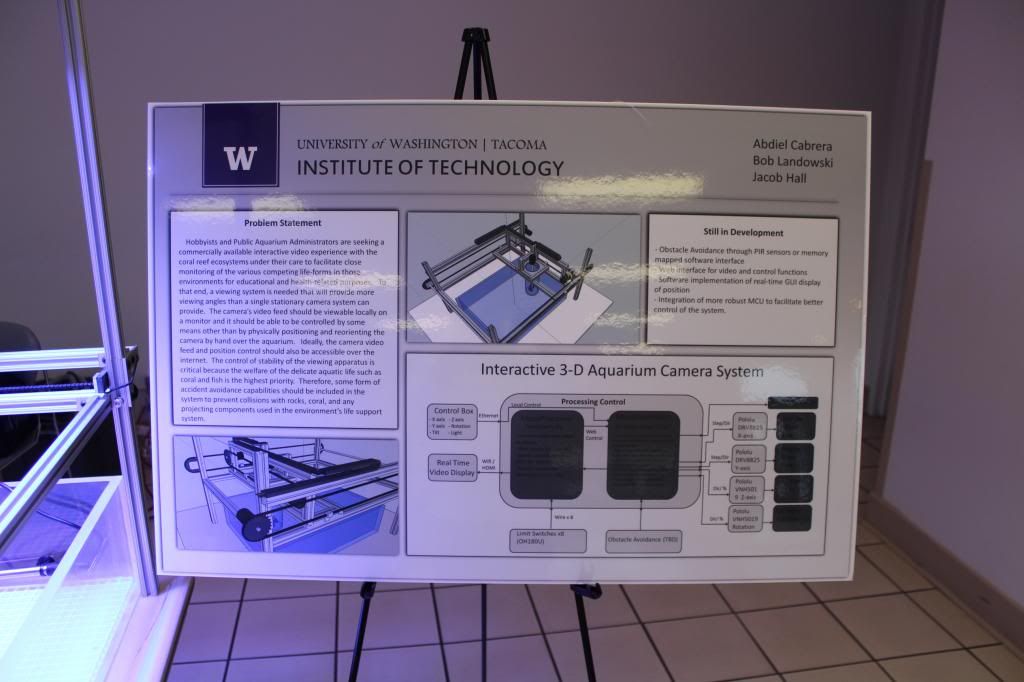
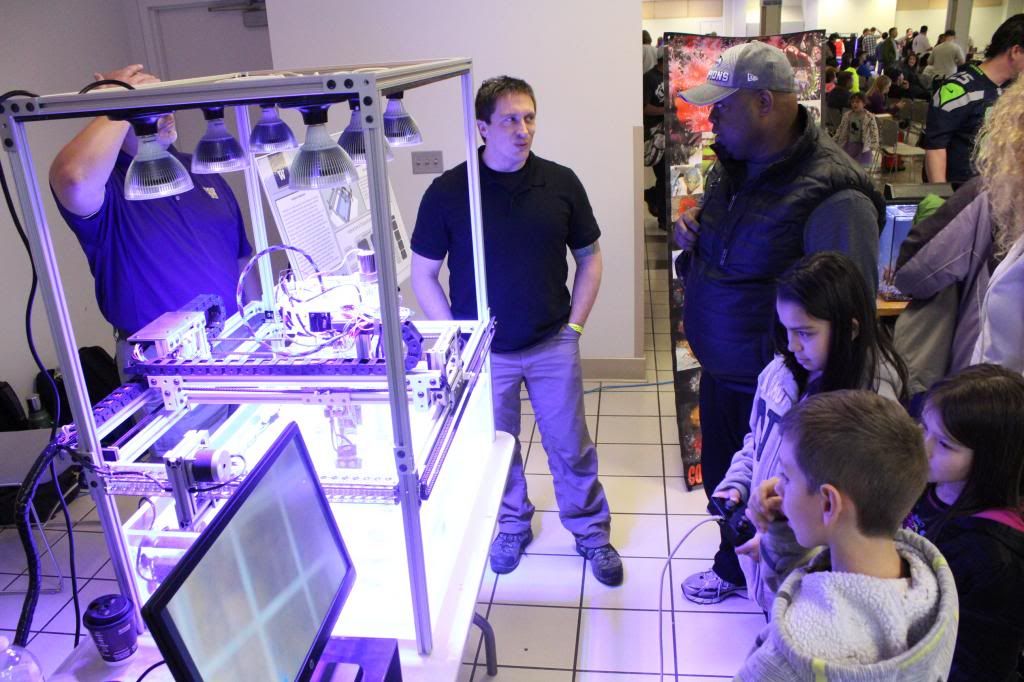
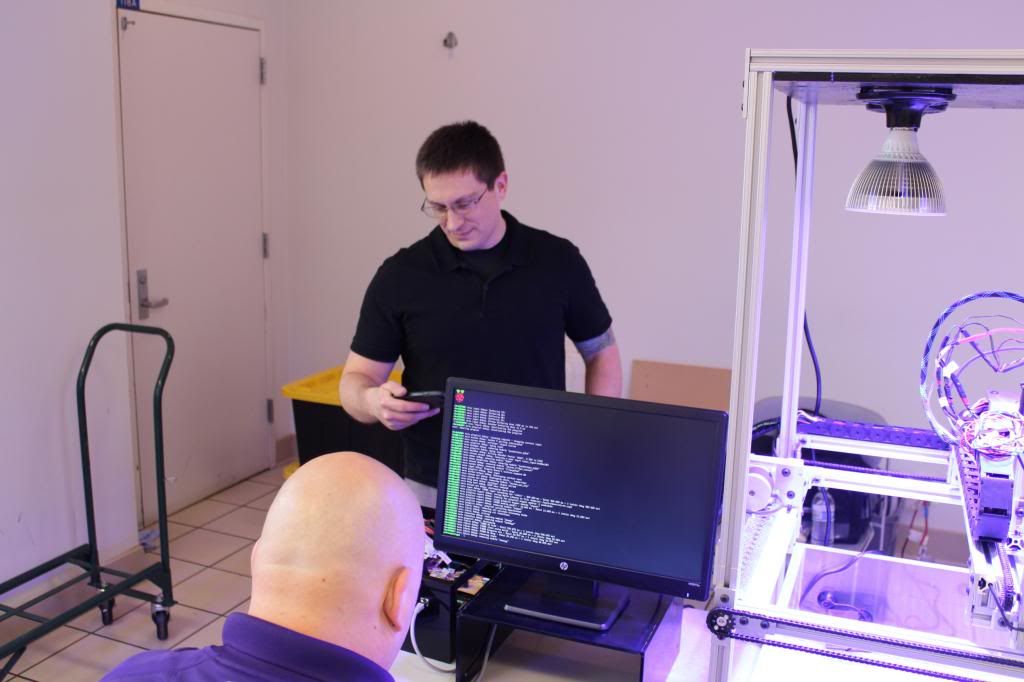

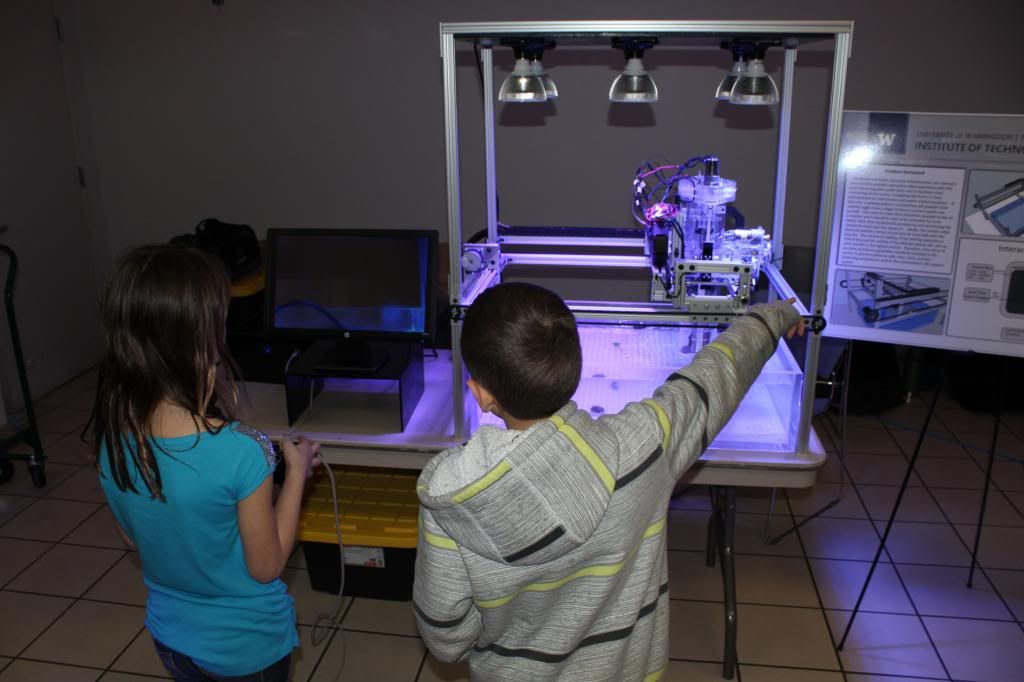
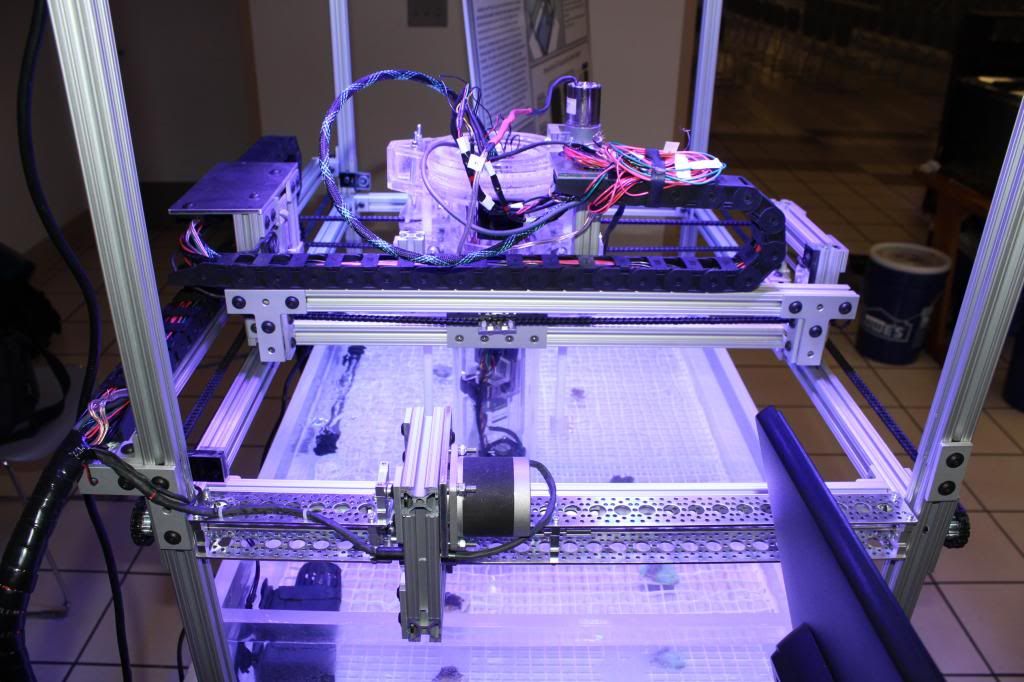
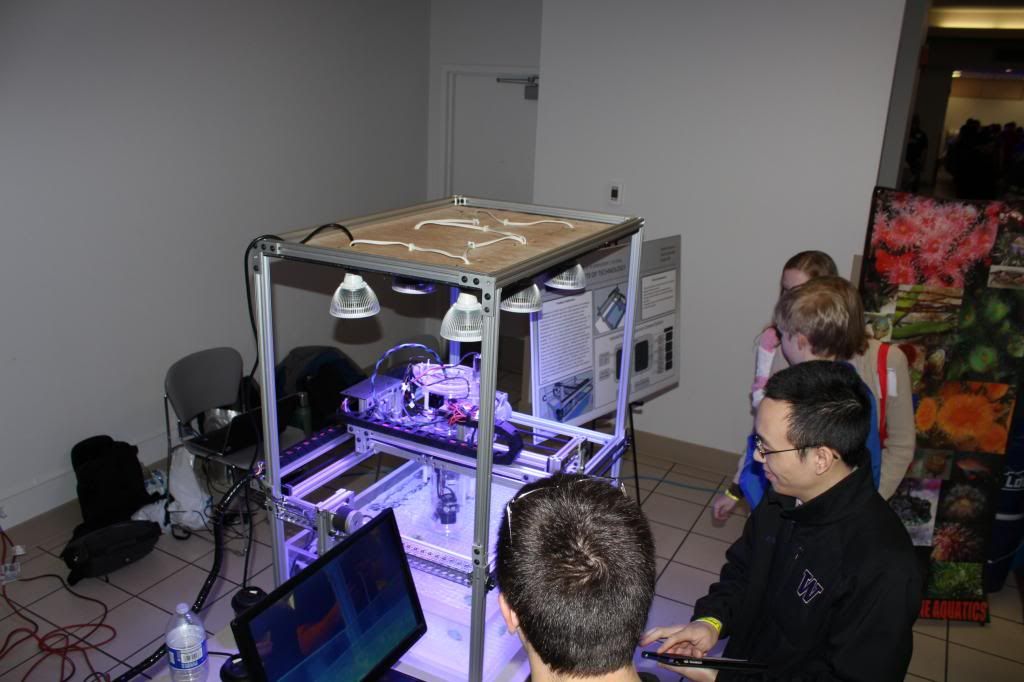
The next step will be the web development portion.
The swap had a great turnout and we were able to collect a lot of good feedback. Most importantly, it was a big hit with the kids. We gave them the game controller and pretty soon, they were demoing it for us showing everyone how to make it work.







sethsolomon;294707 said:
I am curious how the camera would react to the super actinic light most reefers use. Most cameras can't do the white balance for it.
Also, I'd like to build a small experimental rig just to drop in someone's tank (just the camera and microprocessor to stream the video) and evaluate how it does in an actual reef tank as opposed to the shallow frag tank were using for display.
Sent from my iPhone using Tapatalk
Things have been pretty quiet with the development of the project because we've been focused on completing a lot of documentation requirements for the University. That is almost done for now. One team member is focusing on the obstacle avoidance. We'll post details about how that turns out once we have some testing results.
I've been focused on getting the web interface up and running. Formally, in our curriculum here, we spend a lot of time writing code in Java and C. Website design is handled by the students in the IT section of the Institute of Tech. So, I've been spending weeks familiarizing myself with html, php, css, javascript, and sql. I have had a domain reserved at GoDaddy for over a year now, but couldn't find time to do anything with it. I finally found a reason to do something with the domain and have a VERY ugly product up and running for my website now.
http://halmusreeftank.com/senior_project.html
There are still some dead links, missing links, and other issues with the site. I intend to use the site to showcase some of the projects and work I've been a part of at UWT. I will also be posting future "reef" projects up on the site as well as pictures of my past SPS tank. It's been a good learning experience. Even though I was using a template from CoffeeCup html editor, I have been playing around with the code and learning how it all fits together.
As a result, I've made a little progress with the site that will host our project's GUI to control movement and view the video feed. All of the buttons are in place. The site is hosted from the microprocessor seen in the picture below. That is the microprocessor that will also transmit the video feed. For testing purposes, the web page buttons are just turning on LED's on a breadboard for now. Those signals will easily work with the existing microcontrollers to dictate movement. I'm going to try to clean up the GUI to make it look a little more professional, but my first goal is to have a working product with the video. Then I can spend more time making it look pretty.

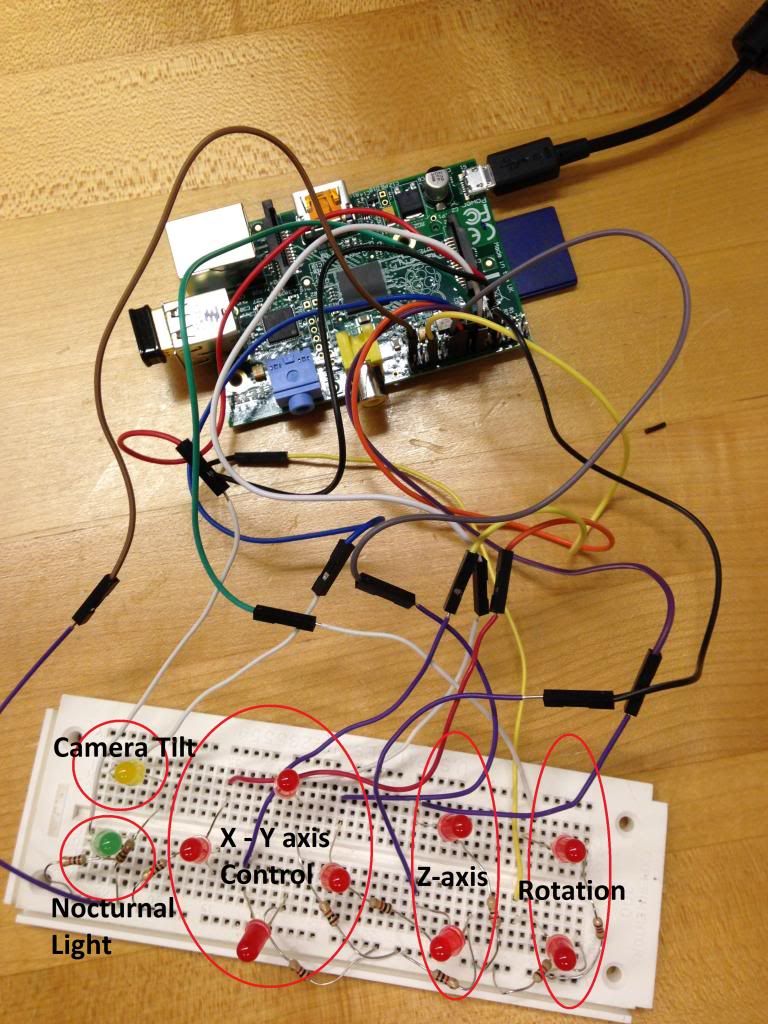
I've been focused on getting the web interface up and running. Formally, in our curriculum here, we spend a lot of time writing code in Java and C. Website design is handled by the students in the IT section of the Institute of Tech. So, I've been spending weeks familiarizing myself with html, php, css, javascript, and sql. I have had a domain reserved at GoDaddy for over a year now, but couldn't find time to do anything with it. I finally found a reason to do something with the domain and have a VERY ugly product up and running for my website now.
http://halmusreeftank.com/senior_project.html
There are still some dead links, missing links, and other issues with the site. I intend to use the site to showcase some of the projects and work I've been a part of at UWT. I will also be posting future "reef" projects up on the site as well as pictures of my past SPS tank. It's been a good learning experience. Even though I was using a template from CoffeeCup html editor, I have been playing around with the code and learning how it all fits together.
As a result, I've made a little progress with the site that will host our project's GUI to control movement and view the video feed. All of the buttons are in place. The site is hosted from the microprocessor seen in the picture below. That is the microprocessor that will also transmit the video feed. For testing purposes, the web page buttons are just turning on LED's on a breadboard for now. Those signals will easily work with the existing microcontrollers to dictate movement. I'm going to try to clean up the GUI to make it look a little more professional, but my first goal is to have a working product with the video. Then I can spend more time making it look pretty.


Dreamer;6206 said:
I'm wanting to make my own rock for my 150g. If anyone has done this. Please help me learn from your mistakes. Share do's and don'ts. Any pictures would be awesome.
Be safe
Dreamer
Be safe
Dreamer
What kind of sensors are you using for the obstacle detection? Keep in mind the effect of aquarium lighting on the saturation of the sensor if you are using IR, as single point lighting sources like halides or kessil leds can introduce a lot of noise into the sensor that needs to be filtered out or compensated. A photoresistor can help give a compensation baseline. If you are using a class 1 or 2 lidar, the light nakes very little difference.
Optimists say the glass is half full. Pessimists say the glass is half empty. Engineers say the glass is twice the size that it needs to be.
FinsUp!;286206 said:
My initial reaction is that the acrylic cylinder isn't needed. GoPro cameras have a waterproof housing, and those would be the ideal cameras to film with. That reduces bulk significantly.
Second reaction is that there's a risk of knocking over coral and rock when mechanically moving something around in the tank, and the majority of my tank would be a no fly zone for that reason.
None of that makes this a less-cool idea, but probably only functional on very large tanks.
Second reaction is that there's a risk of knocking over coral and rock when mechanically moving something around in the tank, and the majority of my tank would be a no fly zone for that reason.
None of that makes this a less-cool idea, but probably only functional on very large tanks.
Optimists say the glass is half full. Pessimists say the glass is half empty. Engineers say the glass is twice the size that it needs to be.
zombie;298703 said:
What kind of sensors are you using for the obstacle detection? Keep in mind the effect of aquarium lighting on the saturation of the sensor if you are using IR, as single point lighting sources like halides or kessil leds can introduce a lot of noise into the sensor that needs to be filtered out or compensated. A photoresistor can help give a compensation baseline. If you are using a class 1 or 2 lidar, the light nakes very little difference.
PHOTODIODE PIN IR 5MM BLACK
EMITTER IR 5MM 940NM CLEAR
IC OPAMP GP 1.2MHZ 14DIP
TRIMMER 10K OHM 0.5W TH
That's the parts list for one single sensor pair. We'll be able to run x4 sensor pairs per x1 op-amp wired as a comparator. The trimmer pot is used for fine adjustment. The plan right now is to have x8 sets of sensor pairs in a halo around the camera housing right at the surface of the water.
We've had to compartmentalize the work quite a bit so I don't have an intimate knowledge of how the testing is going. I will definitely make sure my team-mate tests the initial prototype under aquarium lighting before we commit to the design.
Thank you for your input. We'll let you know what final design we go with.
Small update:
We almost have the web portion of the project in a workable state. The website is created now and all of the buttons are in place and working. I need to do a little cleaning work with the GUI to make it more user friendly. Besides the buttons that you can see on the screen, there are "hotkeys" mapped from the keypad to move the various axes so that you don't have to rely on just clicking a mouse. The video is streaming to the site. That is something I will be trying to optimize later on because there is latency that we may never be able to get rid of due to the nature of the internet. It's a 2-3 second delay in the video stream, although the movement commands go through instantly. That makes the behavior a little annoying. The other issue that we hopefully can improve on is the video image. It's a really great image straight to a local monitor, but the video over the internet is not impressive. We are going to mess around with buffering it to improve the quality.
However, we're taking it one step at a time. It's working for now, so we're focusing on wiring in the new components into the system so that one member can optimize all of the hardware movement while I concentrate on tweeking some of the software for the video feed. I'm also going to be rebuilding the power supply because we've added some features to the system that weren't originally planned on like the nocturnal lights. Even though they're just a novelty, they might be something that could be useful some day. Like a late-night bristleworm hunt? The nocturnal lights are two red LED's we purchased through Rapid. They require a significant amount of current.
The obstacle avoidance portion is still being redesigned. The op-amp wasn't the most ideal IC to use, the other member is testing a Comparator IC.
I'll post up a video of the web portion once it's fully integrated. Eventually, I should be able to post the link up here so you can play with it. But, I may have to create some sort of queue so that only one person can actually have control of movement at a time.
We almost have the web portion of the project in a workable state. The website is created now and all of the buttons are in place and working. I need to do a little cleaning work with the GUI to make it more user friendly. Besides the buttons that you can see on the screen, there are "hotkeys" mapped from the keypad to move the various axes so that you don't have to rely on just clicking a mouse. The video is streaming to the site. That is something I will be trying to optimize later on because there is latency that we may never be able to get rid of due to the nature of the internet. It's a 2-3 second delay in the video stream, although the movement commands go through instantly. That makes the behavior a little annoying. The other issue that we hopefully can improve on is the video image. It's a really great image straight to a local monitor, but the video over the internet is not impressive. We are going to mess around with buffering it to improve the quality.
However, we're taking it one step at a time. It's working for now, so we're focusing on wiring in the new components into the system so that one member can optimize all of the hardware movement while I concentrate on tweeking some of the software for the video feed. I'm also going to be rebuilding the power supply because we've added some features to the system that weren't originally planned on like the nocturnal lights. Even though they're just a novelty, they might be something that could be useful some day. Like a late-night bristleworm hunt? The nocturnal lights are two red LED's we purchased through Rapid. They require a significant amount of current.
The obstacle avoidance portion is still being redesigned. The op-amp wasn't the most ideal IC to use, the other member is testing a Comparator IC.
I'll post up a video of the web portion once it's fully integrated. Eventually, I should be able to post the link up here so you can play with it. But, I may have to create some sort of queue so that only one person can actually have control of movement at a time.
It's been a long time since I updated here. The web portion is as done as it's going to get. You can see what the website looks like in the video:
[video=youtube;GCuJqqbf5wk]https://www.youtube.com/watch?v=GCuJqqbf5wk[/video]
Two major self-criticisms I have at this time:
1. Latency of video and the quality. Obviously this isn't ideal. I am working on a couple options to try to optimize the video quality. If anything is useful in this entire project, it is the possibility of making minor camera angle adjustments with a video streaming to the web.
2. Controlling the system currently is challenging. It's very easy and intuitive to manipulate while you're looking at the system itself. The buttons communicate commands to the machine through the web interface just fine. However, as the camera rotates 360 degrees, you loose orientation with what left and right are. (If you turn around 180 degrees, what was your right before is now your left but the system doesn't know that.) A proposed solution that would not be all that hard to implement would be to keep track of what cardinal direction the camera is pointed in. That information could be handled in the code to intuitively adapt right/left and forward/backward relative to whatever direction the camera is facing. Again, this wouldn't be all that hard, but it would take time that our team doesn't currently have.
[video=youtube;GCuJqqbf5wk]https://www.youtube.com/watch?v=GCuJqqbf5wk[/video]
Two major self-criticisms I have at this time:
1. Latency of video and the quality. Obviously this isn't ideal. I am working on a couple options to try to optimize the video quality. If anything is useful in this entire project, it is the possibility of making minor camera angle adjustments with a video streaming to the web.
2. Controlling the system currently is challenging. It's very easy and intuitive to manipulate while you're looking at the system itself. The buttons communicate commands to the machine through the web interface just fine. However, as the camera rotates 360 degrees, you loose orientation with what left and right are. (If you turn around 180 degrees, what was your right before is now your left but the system doesn't know that.) A proposed solution that would not be all that hard to implement would be to keep track of what cardinal direction the camera is pointed in. That information could be handled in the code to intuitively adapt right/left and forward/backward relative to whatever direction the camera is facing. Again, this wouldn't be all that hard, but it would take time that our team doesn't currently have.
charleshardy5;308613 said:
Perhaps to help with the orientation issue another solution would be to program a function to reorient the camera in the initial direction
We do actually reset the entire system whenever it is turned off and back on again. One member was actually working on mapping the movement so that a graphic on the web page could update with an animation of the approximate position and orientation of the camera. With that functionality, he needed to start from the "origin" every time and keep track of an approximate grid location. It was still a less elegant solution. Ideally, the user could navigate through the tank like you might in a video game. Forward is forward no matter which cardinal direction you're facing. (Even if that means move right on the x-axis or at a 45 deg angle on the X and Y axis simultaneously.) I plan on setting this system up at my house in the future for the fun of it. Maybe I'll have time to implement the fun stuff while I'm getting settled in after the move to Denver.
Thanks for the feedback.
